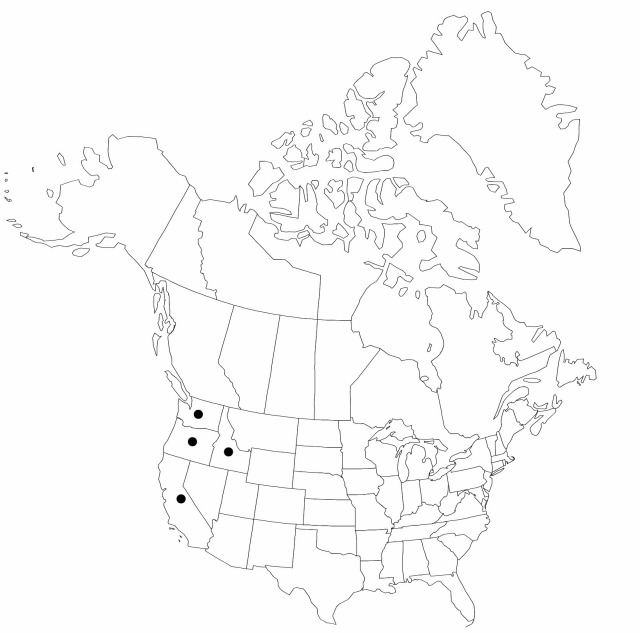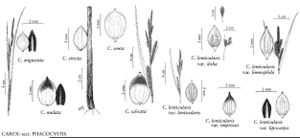Carex lenticularis var. impressa
Syst. Bot. Monogr. 7: 65. 1985.
IllustratedEndemic
Basionym: Carex interrupta var. impressa L. H. Bailey Mem. Torrey Bot. Club 1: 18. 1889
Synonyms: Carex limnaea T. Holm Carex paucicostata Mackenzie
Culms 15–60 cm. Leaf-blades 2–3.5 mm wide. Inflorescences: peduncle of proximal spike 1 cm; proximal bract redbrown at base, 1–3 mm wide. Spikes: proximal 3–5 spikes pistillate, 1.5–3.6 cm × 3–4 mm; terminal spike staminate. Pistillate scales redbrown or black. Perigynia with purple-brown spots on apical 1/2, 1–3 veins abaxially, ellipsoid or ovoid, 1.8–2.5 × 1.1–1.5 mm; stipe 0.2 mm; beak redbrown, 0.2–0.5 mm. 2n = 92.
Phenology: Fruiting Aug.
Habitat: Seasonally flooded river and lakeshores
Elevation: 1200–3000 m
Distribution
Loading map...

Calif., Idaho, Oreg., Wash.
Discussion
Primarily a taxon of the Sierra Nevada and southern Cascade Mountains, Carex lenticularis var. impressa tends to have smaller perigynia with fewer veins and more red-brown pigmentation than does the more widespread var. lipocarpa.
Selected References
None.
Lower Taxa
None.
"shortened" is not a number.
... more about "Carex lenticularis var. impressa"
glaucous +
biconvex +
not constricted +
basifixed +
awnless +
truncate +
prolonged +
glabrous +
acute;obtuse +
purple-brown spots +
brown +
truncate +
terminal +
amphistomic +
absent +
papillose +
leaflike +
1;many +
2;3 +
glabrous +
papillose +
glabrous +
angled +
basal +
abundant +
single +
unisexual +
entire +
Present +
racemose +
pseudoumbel +
modified +
pistillate +
androgynous +
2mm;3.5mm +
absent +
fused +
prominent +
distinct +
arranged +
falling +
absent +
with - 1-3-6 - -30 bristles and/or scales +
thin +
green +
ascending +
2-3 - -4-carpellate +
fused +
pistillate +
subtending +
redbrown +
scale-like +
pistillate +
long-awned +
Syst. Bot. Monogr. +
1985 +
arranged +
adventitious +
fibrous +
pistillate +
shorter +
1;0;1 +
fertile +
2-keeled +
membranous +
glabrous +
cylindric +
pistillate +
arranged +
erect +
1-flowered +
entire +
lacking +
distinct +
papillate +
undivided +
deciduous +
2-3 - -4-fid +
Carex lenticularis var. impressa +
Carex lenticularis +
variety +
staminate +
gynecandrous +
free +
thin +
entire +
ovoid;ellipsoid +
rhizomatous +
perennial +
short to long +
27;48 +
